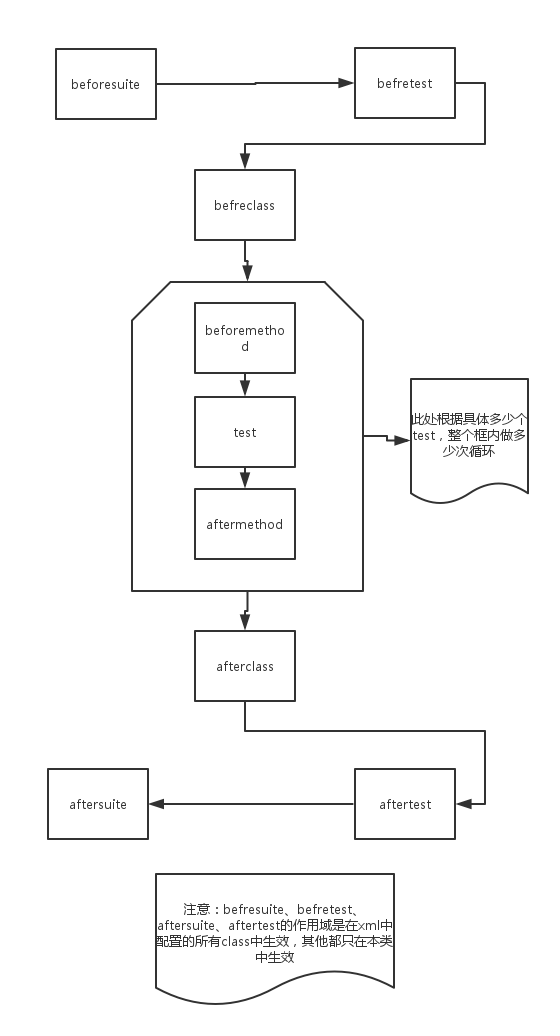testNG注解
本文主要包含testNG注解的使用方法和执行顺序两部分。
一、使用方法
testNG的注解的使用,主要用于方法上 @符号标示,@Test、@afterMethod、@BeforeClass、@BeforeMethod
二、执行顺序
单个类:
根据以下代码执行的结果,我们可以看出来,testNG的执行顺序是
@BeforeSuite->@BeforeTest->@BeforeClass->{@BeforeMethod->@Test->@AfterMethod}->@AfterClass->@AfterTest->@AfterSuite
其中{}内的与多少个@Test,就循环执行多少次。比如下面代码中有两个方法被@Test标识。如果存在继承关系 ,则先执行父类 ,再执行子类。
1 package com.course.testng; 2 3 import org.testng.annotations.*; 4 5 public class BasicAnnotation { 6 @Test 7 public void testCase1() { 8 System.out.println("@Test这是测试用例1"); 9 } 10 11 @BeforeMethod 12 public void beforeMethod() { 13 System.out.println("beforeMethod这是在测试方法之前运行的"); 14 } 15 16 @AfterMethod 17 public void afterMethod() { 18 System.out.println("AfterMethod这是在测试方法之后运行"); 19 } 20 21 @Test 22 public void testCase2() { 23 System.out.println("@Test这是测试用例2"); 24 } 25 26 @BeforeClass 27 public void beforClass() { 28 System.out.println("BeforeClass这是类运行之前的方法"); 29 30 } 31 32 @AfterClass 33 public void afterClass() { 34 System.out.println("afterClass类运行之后的方法"); 35 } 36 37 @BeforeSuite 38 public void beforeSuite() { 39 System.out.println("BeforeSuitec测试套件"); 40 } 41 42 @AfterSuite 43 public void afterSuite() { 44 System.out.println("AfterSuite测试套件"); 45 } 46 47 @BeforeTest 48 public void beforeTest() { 49 System.out.println("BeforeTest这是在每个Test之前运行"); 50 } 51 52 @AfterTest 53 public void afterTest() { 54 System.out.println("AfterTest这是在每个Test之后运行"); 55 } 56 }
以下是运行结果
3 C:UsersAdministrator.IntelliJIdea2019.3system emp-testng-customsuite.xml 4 5 BeforeSuitec测试套件 6 7 BeforeTest这是在每个Test之前运行 8 9 BeforeClass这是类运行之前的方法 10 11 beforeMethod这是在测试方法之前运行的 12 13 @Test这是测试用例1 14 15 AfterMethod这是在测试方法之后运行 16 17 beforeMethod这是在测试方法之前运行的 18 19 @Test这是测试用例2 20 21 AfterMethod这是在测试方法之后运行 22 23 afterClass类运行之后的方法 24 25 AfterTest这是在每个Test之后运行 26 27 AfterSuite测试套件 28 29 =============================================== 30 Default Suite 31 Total tests run: 2, Failures: 0, Skips: 0 32 =============================================== 33 34 Process finished with exit code 0

多个类:
@BeforeSuite(按类顺序执行)->@BeforeTest(按类顺序执行)->@BeforeClass->{@BeforeMethod->@Test->@AfterMethod}->@AfterClass ->@AfterTest->@AfterSuite
黑色部分 按XML中配置的顺序执行,即执行你一个类中的@BeforeSuite 第二个类中的@BeforeSuite ,第一个类中的@BeforeTest,第二个类中的@BeforeTest
红色部分 则需要一个类中的所有test(@BeforeClass->{@BeforeMethod->@Test->@AfterMethod}->@AfterClass)执行完毕之后,再执行第二个类中的test 。
第一个类中的代码
1 package com.course.testng; 2 3 import org.testng.annotations.*; 4 5 public class BasicAnnotation { 6 @Test 7 public void testCase1() { 8 System.out.println("@Test这是测试用例1"); 9 } 10 11 @BeforeMethod 12 public void beforeMethod() { 13 System.out.println("beforeMethod这是在测试方法之前运行的"); 14 } 15 16 @AfterMethod 17 public void afterMethod() { 18 System.out.println("AfterMethod这是在测试方法之后运行"); 19 } 20 21 @Test 22 public void testCase2() { 23 System.out.println("@Test这是测试用例2"); 24 } 25 26 @BeforeClass 27 public void beforClass() { 28 System.out.println("BeforeClass这是类运行之前的方法"); 29 30 } 31 32 @AfterClass 33 public void afterClass() { 34 System.out.println("afterClass类运行之后的方法"); 35 } 36 37 @BeforeSuite 38 public void beforeSuite() { 39 System.out.println("BeforeSuitec测试套件"); 40 } 41 42 @AfterSuite 43 public void afterSuite() { 44 System.out.println("AfterSuite测试套件"); 45 } 46 47 @BeforeTest 48 public void beforeTest() { 49 System.out.println("BeforeTest这是在每个Test之前运行"); 50 } 51 52 @AfterTest 53 public void afterTest() { 54 System.out.println("AfterTest这是在每个Test之后运行"); 55 } 56 }
第二个类中的代码
1 package com.course.testng; 2 3 import org.testng.annotations.*; 4 5 public class CpBasicAnnotation { 6 @Test 7 public void testCase1() { 8 System.out.println("@Test这是测试用例1__________CpBasicAnnotation"); 9 } 10 11 @BeforeMethod 12 public void beforeMethod() { 13 System.out.println("beforeMethod这是在测试方法之前运行的__________CpBasicAnnotation"); 14 } 15 16 @AfterMethod 17 public void afterMethod() { 18 System.out.println("AfterMethod这是在测试方法之后运行__________CpBasicAnnotation"); 19 } 20 21 @Test 22 public void testCase2() { 23 System.out.println("@Test这是测试用例__________CpBasicAnnotation2"); 24 } 25 26 @BeforeClass 27 public void beforClass() { 28 System.out.println("BeforeClass这是类运行之前的方法__________CpBasicAnnotation"); 29 30 } 31 32 @AfterClass 33 public void afterClass() { 34 System.out.println("afterClass类运行之后的方法__________CpBasicAnnotation"); 35 } 36 37 @BeforeSuite 38 public void beforeSuite() { 39 System.out.println("BeforeSuitec测试套件__________CpBasicAnnotation"); 40 } 41 42 @AfterSuite 43 public void afterSuite() { 44 System.out.println("AfterSuite测试套件__________CpBasicAnnotation"); 45 } 46 47 @BeforeTest 48 public void beforeTest() { 49 System.out.println("BeforeTest这是在每个Test之前运行__________CpBasicAnnotation"); 50 } 51 52 @AfterTest 53 public void afterTest() { 54 System.out.println("AfterTest这是在每个Test之后运行__________CpBasicAnnotation"); 55 } 56 57 }
xml配置文件
1 <?xml version="1.0" encoding="UTF-8" ?> 2 <suite name="suitname"> 3 <test name="runAll"> 4 <classes> 5 <class name="com.course.testng.BasicAnnotation"/> 6 <class name="com.course.testng.CpBasicAnnotation"/> 7 </classes> 8 </test> 9 </suite>
运行结果如下
1 BeforeSuitec测试套件 2 BeforeSuitec测试套件__________CpBasicAnnotation 3 BeforeTest这是在每个Test之前运行 4 BeforeTest这是在每个Test之前运行__________CpBasicAnnotation 5 6 BeforeClass这是类运行之前的方法 7 beforeMethod这是在测试方法之前运行的 8 @Test这是测试用例1 9 AfterMethod这是在测试方法之后运行 10 beforeMethod这是在测试方法之前运行的 11 @Test这是测试用例2 12 AfterMethod这是在测试方法之后运行 13 afterClass类运行之后的方法 14 15 16 BeforeClass这是类运行之前的方法__________CpBasicAnnotation 17 beforeMethod这是在测试方法之前运行的__________CpBasicAnnotation 18 @Test这是测试用例1__________CpBasicAnnotation 19 AfterMethod这是在测试方法之后运行__________CpBasicAnnotation 20 beforeMethod这是在测试方法之前运行的__________CpBasicAnnotation 21 @Test这是测试用例__________CpBasicAnnotation2 22 AfterMethod这是在测试方法之后运行__________CpBasicAnnotation 23 afterClass类运行之后的方法__________CpBasicAnnotation 24 25 26 AfterTest这是在每个Test之后运行 27 AfterTest这是在每个Test之后运行__________CpBasicAnnotation 28 AfterSuite测试套件 29 AfterSuite测试套件__________CpBasicAnnotation 30 31 =============================================== 32 suitname 33 Total tests run: 4, Failures: 0, Skips: 0 34 =============================================== 35 Process finished with exit code 0